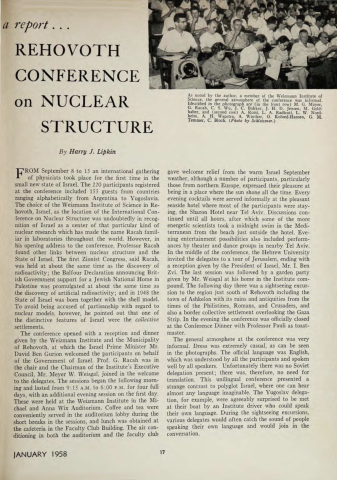Rehovoth Conference on Nuclear Structure

FROM September 8 to 15 an international gathering of physicists took place for the first time in the small new state of Israel. The 220 participants registered at the conference included 155 guests from countries ranging alphabetically from Argentina to Yugoslavia. The choice of the Weizmann Institute of Science in Rehovoth, Israel, as the location of the International Conference on Nuclear Structure was undoubtedly in recognition of Israel as a center of that particular kind of nuclear research which has made the name Racah familiar in laboratories throughout the world. However, in his opening address to the conference, Professor Racah found other links between nuclear structure and the State of Israel. The first Zionist Congress, said Racah, was held at about the same time as the discovery of radioactivity; the Balfour Declaration announcing British Government support for a Jewish National Home in Palestine was promulgated at about the same time as the discovery of artificial radioactivity; and in 1948 the State of Israel was born together with the shell model. To avoid being accused of partisanship with regard to nuclear models, however, he pointed out that one of the distinctive features of Israel were the collective settlements.
The conference opened with a reception and dinner given by the Weizmann Institute and the Municipality of Rehovoth, at which the Israel Prime Minister Mr. David Ben Gurion welcomed the participants on behalf of the Government of Israel. Prof. G. Racah was in the chair and the Chairman of the Institute's Executive Council, Mr. Meyer W. Weisgal, joined in the welcome to the delegates. The sessions began the following morning and lasted from 9:15 A.M. to 6:00 P.M. for four full days, with an additional evening session on the first day. These were held at the Weizmann Institute in the Michael and Anna Wix Auditorium. Coffee and tea were conveniently served in the auditorium lobby during the short breaks in the sessions, and lunch was obtained at the cafeteria in the Faculty Club Building. The air conditioning in both the auditorium and the faculty club gave welcome relief from the warm Israel September weather, although a number of participants, particularly those from northern Europe, expressed their pleasure at being in a place where the sun shone all the time. Every evening cocktails were served informally at the pleasant seaside hotel where most of the participants were staying, the Sharon Hotel near Tel Aviv. Discussions continued until all hours, after which some of the more energetic scientists took a midnight swim in the Mediterranean from the beach just outside the hotel. Evening entertainment possibilities also included performances by theater and dance groups in nearby Tel Aviv. In the middle of the conference, the Hebrew University invited the delegates to a tour of Jerusalem, ending with a reception given by the President of Israel, Mr. I. Ben Zvi. The last session was followed by a garden party given by Mr. Weisgal at his home in the Institute compound. The following day there was a sightseeing excursion to the region just south of Rehovoth including the town of Ashkelon with its ruins and antiquities from the times of the Philistines, Romans, and Crusaders, and also a border collective settlement overlooking the Gaza Strip. In the evening the conference was officially closed at the Conference Dinner with Professor Pauli as toastmaster.
,THE two parity sessions were considerably less turbulent than had been expected a few weeks before, when different laboratories had obtained contradictory results for parity experiments, particularly the measurement of beta-ray polarization. The parity experimentalists succeeded in settling their differences among themselves just before the conference and presented a "united front", to the great disappointment of certain theorists who had hoped to see a big scrap. It was now admitted by all concerned that all reliable results obtained thus far for beta-ray polarization were consistent with full polarization in all cases, left-handed for negatons and right-handed for positons. Only the recoil experiments measuring electron-neutrino angular correla-tion still presented a confused picture of mutually inconsistent experimental results.
These sessions began with a series of lectures presenting an excellent survey of the present state of beta decay. E. J. Konopinski presented a summary of the conclusions regarding the nature of the beta-decay interaction which were obtainable from "classical" (before parity) experiments. He stressed the revisions necessary in these conclusions in view of the nonconservation of parity, particularly those drawn from the absence of Fierz interference. The weakening of these conclusions left accurate recoil experiments as the only method for determining the beta interaction. T. D. Lee then presented the theoretical aspects of parity nonconservation in beta decay, treating a four-component neutrino, introducing the concept of helicity, and pointing out the simplifications possible if lepton conservation and twocomponent theory were valid. C. S. Wu presented the experimental aspects of parity conservation, including a description of the different types of new parity experiments and a summary of the present state of experimental data.
The session concluded with report on the recent controversial recoil experiments by Allen et al. on A35 (presented by H. Frauenfelder) and Ridley et al. on Ne23 (presented by P. E. Cavanagh), after which Chairman 0. Kofoed-Hansen concluded that since it had taken two years of careful work in these difficult recoil experiments to reach the present confused state, it would probably take another two years to clear it up.